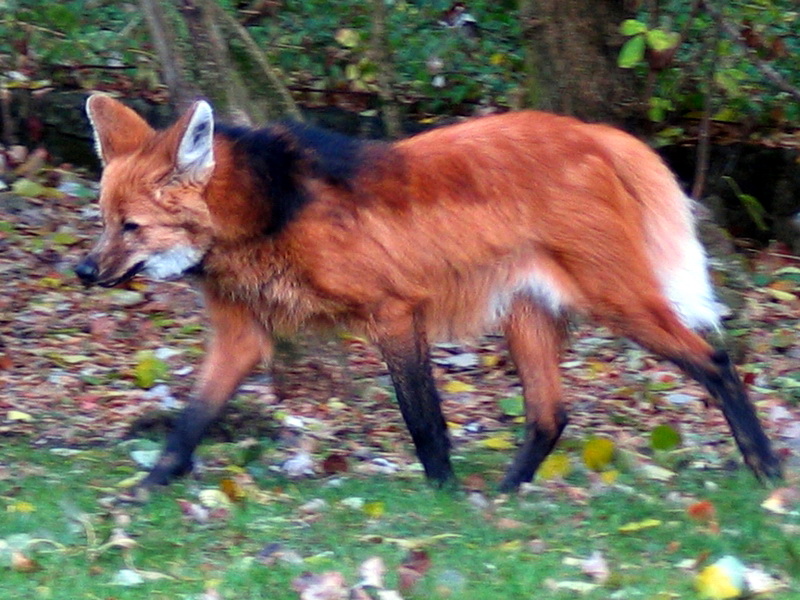Maned Wolf (Chrysocyon brachyurus) - Wiki Maned Wolf
From Wikipedia, the free encyclopedia
[Photo] Maned Wolf (Chrysocyon brachyurus). Maned wolf (aguar?? guaz??). Taken from Polish wikipedia. Dixi (c) 2005 na bazie GNU FDL. http://pl.wikipedia.org/wiki/Wikipedysta:Dixi
The Maned Wolf (Chrysocyon brachyurus) is the largest canid of South America, resembling a big fox with reddish fur. It is called lobo-guar?? ("Guar?? Wolf") in Portuguese, aguara guaz?? ("Big Fox") in Guarani, and lobo de crin ("Maned Wolf") in Spanish. It was improperly called Canis jubatus ("Maned Dog") in some 19th century publications.
The distribution includes southern Brazil, Paraguay, and Bolivia east of the Andes. It is an endangered species, and its range once included Uruguay and northern Argentina, although IUCN lists it as "lower risk". It is the only species in the genus Chrysocyon.
Description
The Maned Wolf has often been described as "a Red Fox on stilts" due to its similar coloration and overall appearance, though it is much larger than a Red Fox and belongs to a different genus. The adult animal stands almost 1 m (3 ft) tall at the shoulder, and weighs 20 to 25 kg. (50 to 55 lb). Its fur is reddish brown to golden orange on the sides, with long, black legs and a distinctive black mane. The coat is further marked with a whitish tuft at the tip of the tail and a white "bib" beneath the throat. The mane is erectile, and is typically used to enlarge the wolf's profile when threatened or when displaying aggression.
Habits
Hunting and territoriality
Unlike other large canids (such as Wolves, African Hunting Dogs, Dholes) the Maned Wolf does not form packs. It hunts alone, usually between sundown and midnight. It kills its animal prey by biting on the neck or back, and shaking it violently if necessary. Monogamous pairs may defend a shared territory of about 30 square km, though the wolves themselves may seldom meet, outside of mating. The territory is criscrossed by paths that the wolves create as they patrol at night. Several adults may congregate in the presence of a plentiful food source; a fire-cleared patch of grassland, for example, which would leave small vertebrate prey exposed to foraging wolves.
Maned Wolves, both male and female, use their urine to communicate, e.g. to mark their hunting paths, or the places where they have buried hunted prey. The urine has a very distinctive smell, which some people liken to hops or cannabis. The responsible substance is very likely a pyrazine, which occurs in both plants. (In the Rotterdam Zoo, this smell once set the police on a hunt for cannabis smokers.)
Reproduction
The mating season ranges from November to February. Gestation lasts 70 to 75 days, and a litter may have up to 2-6 pups, each weighing about 450 g (1 lb).
Diet
Maned Wolves specialize in small and medium-sized prey, including small animals (rodents, hares), birds, and even fish. A large fraction of their diet (over 50%, according to some studies) is vegetable matter, including sugarcane, tubers, and fruit---especially Wolf Apples, the tomato-like fruit of the Lobeira (Solanum lycocarpum). Captive maned wolves were traditionally fed meat-heavy diets and developed kidney stones. Zoo diets now feature fruits and vegetables, as well as meat and dog chow.
Relations with other species
Maned Wolves participate in symbiotic relationships with the plants that they feed on, as they carry the seeds of various plants, and often defecate on the nests of the leaf-cutting ant. The ants then use the dung to fertilize their fungus gardens, and later discard the seeds onto refuse piles just outside their nest. This process significantly increases the germination rate of the seeds. The wolf is particularly susceptible to renal nematode infections, a potentially fatal parasite. The Maned Wolf is not a true, common prey species for any other predator, though it may be attacked or killed by feral domestic dogs. The puma is a potential competitor.
Relations with man
The Maned Wolf is said to be a potential chicken thief; it was once also considered a threat to cattle and sheep, though this is now known to be false. In Brazil, the animal was historically hunted down for some body parts, notably the eyes, that were believed to be good luck charms. However, as they are now classified as endangered by the Brazilian government, they are afforded protection from poachers. Wolves are also endangered by habitat loss and being run over by cars, though there are some positive benefits from the conversion of forest into grassland by humans. Wolves risk both physical harm and catching diseases from domestic dogs. The Maned Wolf is shy and flees when alarmed, and it poses little direct threat to man. Maned Wolves are well represented in captivity, and have been bred successfully at a number of zoos like in Argentina.
Taxonomy
The Maned Wolf is not closely related to any other canid. It is apparently a survivor from the Pleistocene fauna of large South American mammals; its closest relatives seem to be the dogs and wolves (genus Canis). Previously, some authorities placed it with the various South American foxes, others with the Bush Dog.
http://en.wikipedia.org/wiki/Maned_Wolf
| The text in this page is based on the copyrighted Wikipedia article shown in above URL. It is used under the GNU Free Documentation License. You may redistribute it, verbatim or modified, providing that you comply with the terms of the GFDL. |
